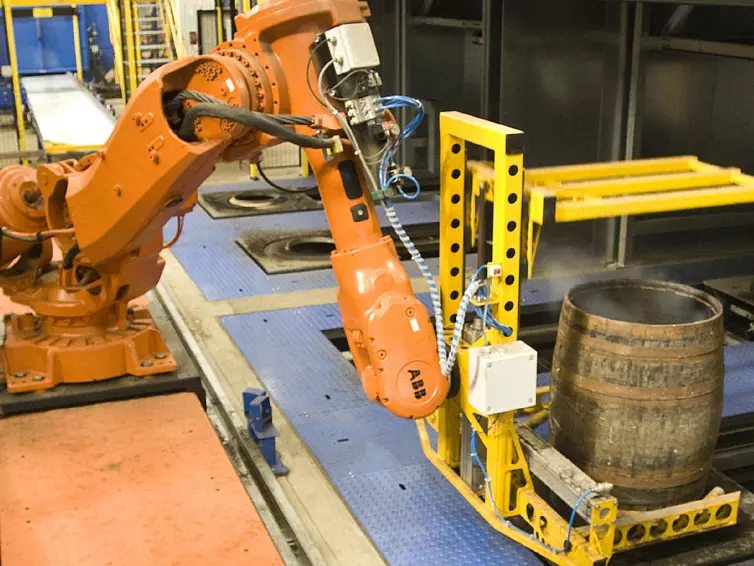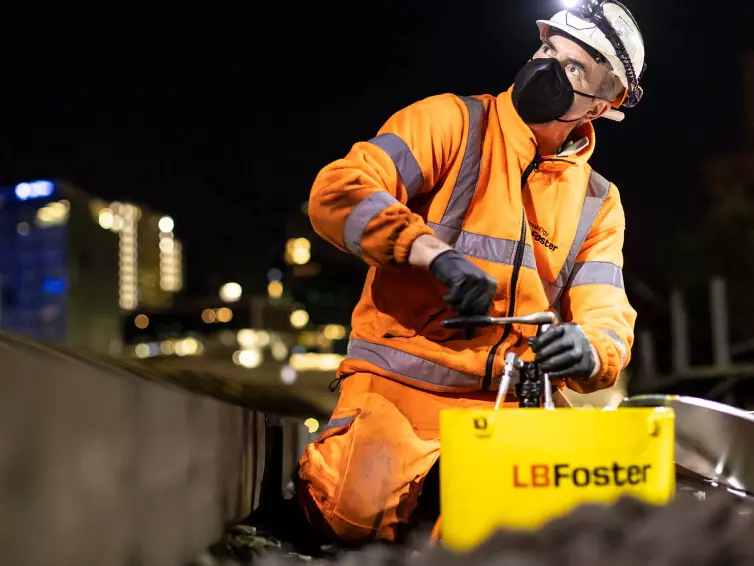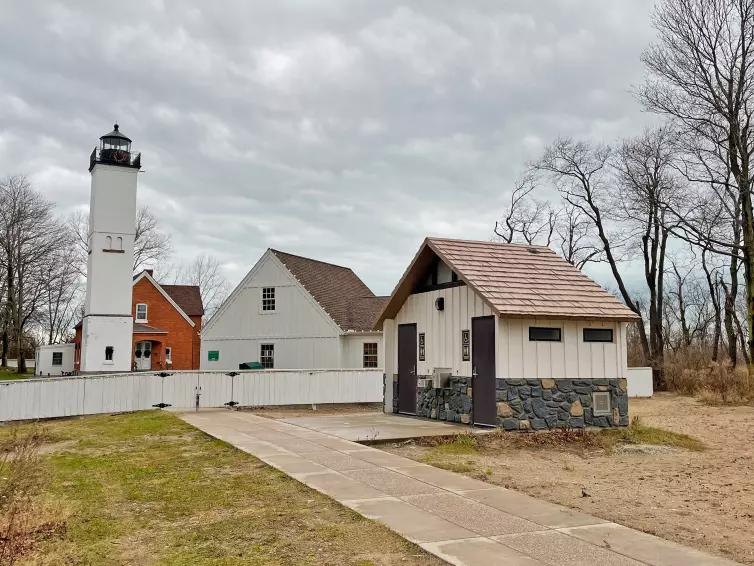Diageo - ATEX compliant conveyor solution
- Aug 16, 2018
- Rail
Innovative, ATEX compliant, conveying solutions with integrated robotics for Diageo's new £10m cooperage.
Introduction
Diageo, the world’s leading premium drinks company, has recently opened a £10m cooperage at its 29-acre site at Cambus, in Clackmannanshire. The new cooperage, which combines materials handling innovation with robotics, is the culmination of a two-year project.
The new cooperage has been constructed to produce 250,000 rejuvenated and rebuilt casks a year, prior to refilling with the company’s famous whisky brands.
Requirement
Alan Hadden, project delivery manager for Diageo on the cooperage development, explains: “A decision was made early in 2009 to review Diageo’s operations in Scotland. At that time the company had two cooperages which together produced approximately 200,000 casks per annum. The challenge we faced was to increase cask production by around 25 per cent. Unfortunately, the existing facilities were not suitable for expansion. So we decided to erect a purpose-built, high-tech cooperage here in Cambus and move our entire cask making operations to this site.”
Coopering is a very physical industry. One of the main drivers behind the design of the new cooperage was introduce automated processes to reduce the manual handling of casks to improve safety.
Alan Hadden continues: “We needed to partner with a company that understood our challenges and which was able to work with us right from the concept stage. We knew L.B. Foster Automation & Materials Handling. They are experienced and professional and we knew we could engage with them. That gave us confidence from day one that they could deliver on this exciting project.
“We invited L.B. Foster to work with us, sharing with them what we needed as a business. They provided their expertise, developing entirely innovative conveying solutions with integrated robotics. What evolved is a strong relationship between our two companies, which has helped deliver the world-class facility we have today.”
What has evolved is a strong relationship between our two companies which has delivered the world class facility we have today. All in all it was a very positive experience to work with a company that not only gives you what you actually want, but also comes up with new ideas.
Our Solution
The Cambus cooperage is home to five different processes:
Rejuvenating casks
repairing casks
enlarging casks
two cask rebuilding processes using different types of staves.
The goal of the L.B. Foster scheme is to automate cask movement throughout each process - synchronising, controlling and delivering the various parts of the casks from the beginning to the end of each line.
A number of challenges had to be overcome: Firstly, the specification of the casks varies greatly in weight from 48kg to 128kg and in height from 855mm to 1300mm. Secondly, each cask is bespoke so has to be paired with its own hoops and ends at the finish of the procedure. Finally, there are the hazardous cooperage processes themselves, including steaming, crozing and charring, which pose specific problems of their own.
Alan Hadden: “L.B. Foster took on all the challenges and provided smart solutions; they even came up with a bespoke piece of equipment for a particular application that wasn’t in the original brief. It was a very positive experience to work with a company that gives you what you actually want, and also comes up with new ideas.
“Once we worked out the automated concepts, L.B. Foster recommended that we invest in a computer simulation software package to mimic the casks travelling through the facility. This justified our investment in the project as we could see the flow of casks throughout the facility, potential bottlenecks and how cask production could be increased by some 25 per cent per year.”
Rejuvination line
There are two main floor conveyor lines running through the cooperage, one for re-building and one for rejuvenation of casks. Before starting on the rejuvenation line, the cask type and size settings are checked into one of the Human Machine Interface (HMI) terminals of the two main control panels. This information is used in a number of key locations around the system for operations, including centralising the cask at cross transfer units and passing the correct information to the robotic system.
Casks are stripped of ends and quarter hoops, which are placed in a cradle on one of two branches of a power and free overhead conveyor. Removed parts are given an identification number and stored on an RF (radio frequency) tag fitted to each carrier. The RF tags are read by code readers at key positions around the system, keeping the parts on the overhead conveyors in synchronisation with the casks travelling along the floor conveyors.
Once tagged, the cooper transfers the casks onto a floor level driven roller bed conveyor mounted on a lift table in a shallow pit. On command, the lift table rises and puts the cask into the conveyor system ready for the next process, de-charring. After this is complete the casks are delivered, two at a time, to the next stage where they are manipulated by two robots onto platens ready for charring. The charring stations are constructed in pairs in an insulated cabinet.
At the end of the line the casks arrive at one of six finishing stations. Approaching each station is a gravity roller section of conveyor complete with brake rollers to slow the cask down. A pneumatic gate is operated by foot pedal and indexes the casks, one at a time, to be reunited with their ends and hoops from the overhead line at the hydraulic heading and hoop driving machines.
Rebuild line
At the start of the rebuild line, the casks are reconstructed with two temporary end plate hoops. These hoops are located on a re-circulating overhead conveyor. The creation of the casks takes place at six cask riser machines from where they are transferred via one of three loading stations onto the main line.
The casks are then accumulated in sets of five and temporary lids are applied prior to them travelling through the steam chamber. Lids are taken off following this operation and temporary bulge and quarter hoops fitted ready for the casks to be loaded into the crozer machines.
After this process, the casks travel onto a powered roller conveyor and are inspected with the assistance of a specially designed semi-automatic turn and tilt machine, one of the additional ideas from L.B. Foster. Here they are transferred onto the main line to enter the charring process and from there to the heading and hoop driving machines at the end of the line.
Efficiency equals cost effectiveness
Tom Duncan is the Production Manager of the new cooperage, he concludes: “With the help of L.B. Foster Automation & Materials Handling we have built a new cooperage that demonstrates Diageo is a leading force in the cask making industry. “The automated processes have not only enabled us to increase production by 25% but also, and more importantly, to improve the safety of the 80 staff who work here. We’ve done that by reducing their manual handling of the casks by 90%, making their work less strenuous and removing them from the more hazardous coopering processes, such as putting the casks into fires or steam chambers. All of that work is now done by robots or automated machines, significantly reducing the health and safety risks. This allows our coopers to focus on the craft skills which remain central to the industry.
“We are now seeing the benefits in terms of cost-effectiveness due to the efficiency of the automated transportation and handling system. At an excess of £2m it was a significant investment for us. The system, however, does everything L.B. Foster said it would do. It is flexible too; the company set up the factory in such a way that we can handle any type of cask through any process and we can change quickly from one process to another or run two in tandem.
“L.B. Foster came to us with a good reputation and they have lived up to both it, and our own high expectations. The team working on the cooperage was exceptional; quick to respond to any challenge, full of ideas and professional throughout the entire project.”
The team working on the cooperage was exceptional; quick to respond to any challenge, full of ideas and professional throughout the entire project.


